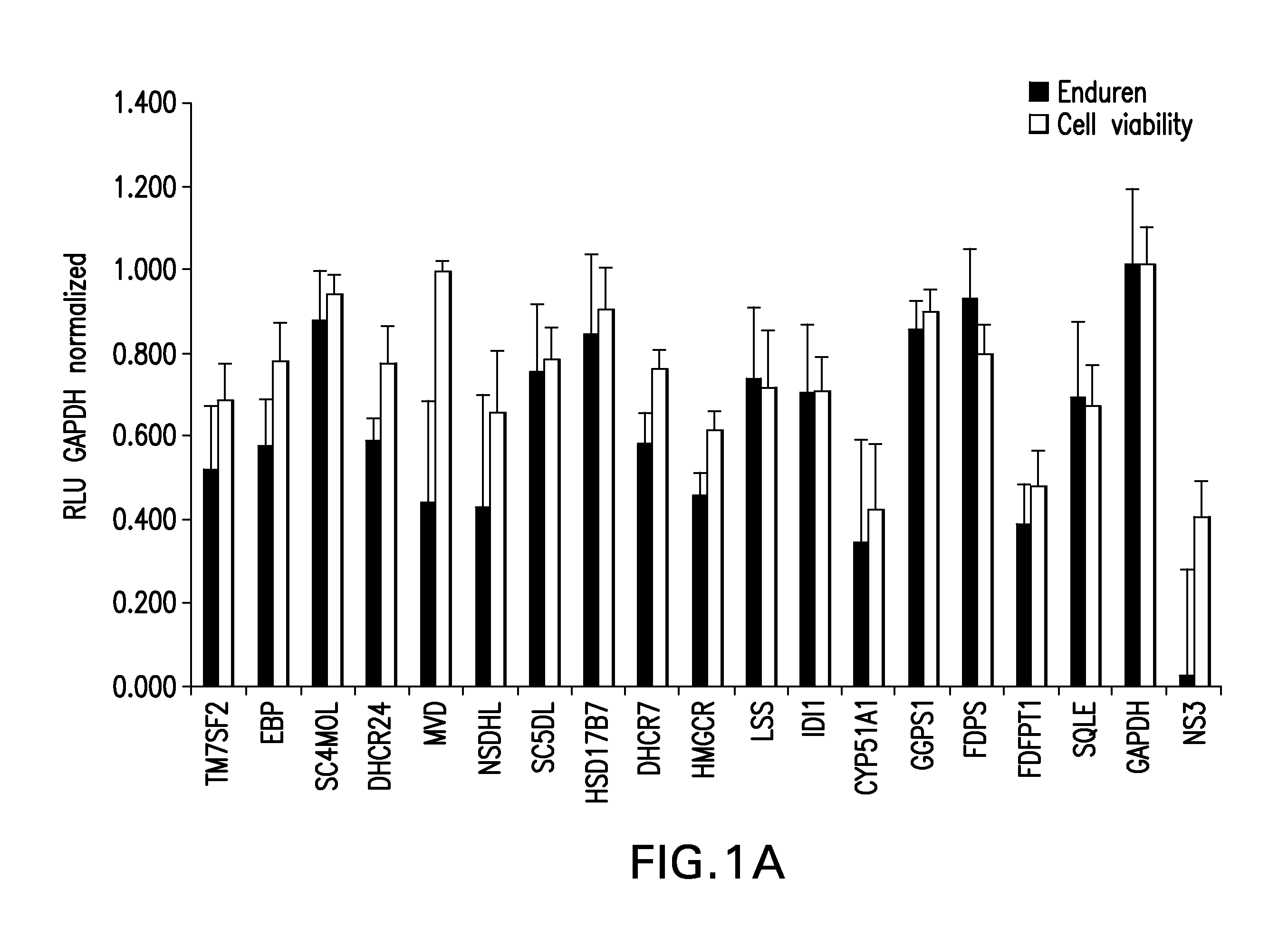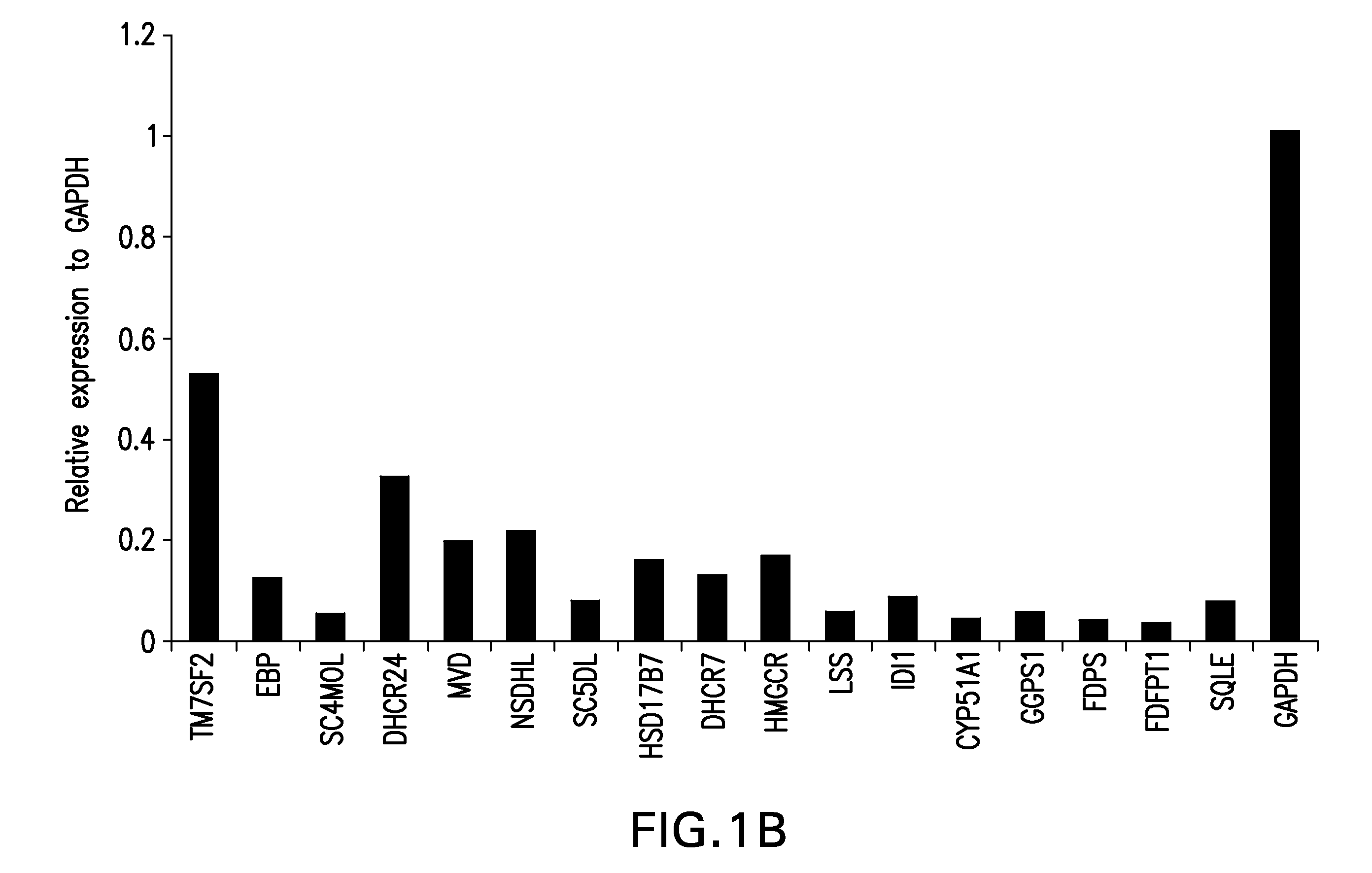Methods of using mevalonate decarboxylase (MVD) antagonists
a technology of mevalonate decarboxylase and antagonist, which is applied in the direction of antibodies, medical ingredients, lyases, etc., can solve the problems of significant challenges, vascular leakage, and hyperactivation of t cells and inappropriate immune reactions, and achieve the effect of inhibiting infection and reducing t cells
- Summary
- Abstract
- Description
- Claims
- Application Information
AI Technical Summary
Benefits of technology
Problems solved by technology
Method used
Image
Examples
example 1
siRNA Analysis of Cholesterol Biosynthetic Genes
[0138]To determine which genes in the cholesterol pathway play a critical role in the replication of the Dengue virus (Flavivirus), a candidate gene-by-gene approach was employed to target cholesterol metabolism using siRNA knock down. Genes with high expression were selected in A549 cells and were either essential or branch point enzymes in the cholesterol biosynthesis pathway (Table 1). Each siRNA was transfected into the A549 Dengue replicon cells as smart pools using siRNA transfection optimization procedures (3). After 72 hours of transfection, cell viability and EnduRen™ levels were measured along with RTPCR (FIGS. 1A and B). The siRNA smart pool targeting MVD (mevalonate diphospho decarboxylase) knocked down target mRNA levels by 80% and had the most significant effect of EnduRen™ levels, 50%. Although most of the siRNAs could potently knock down their respective mRNAs, the phenotypes were modest.
[0139]To further validate the ro...
example 2
Host Cholesterol Pathway Changes During Infection
[0141]Targeting MVD inhibits endogenous cholesterol production, as well as increases mevalonic acid levels in the cell. It is possible Dengue replication depends on the production of endogenous cholesterol production because the virus requires lipid rafts to replicate and traffic in the cell (19). To explore how cholesterol levels are affected by Dengue infection, the cholesterol content in A549 cells were measured after Dengue live virus infection for various times. The total cholesterol content of the cells did not change significantly after infection. Cholesterol is most enriched in the plasma membrane and is less abundant in the endoplasmic reticulum (13). Although the total cholesterol did not change, a local change of cholesterol at the replication site cannot be ruled out. To detect the potential local change in cholesterol, the messenger level of HMGCoAR and LDLR (whose transcriptions were tightly controlled by the level of ch...
example 3
Pharmacological Inhibition of Cholesterol Biosynthesis
[0143]To determine if endogenous cholesterol production was important for Dengue replication, several known cholesterol inhibitors were analyzed in virus infection in K562 cells (a hematopoetic cell line derived from human chronic myelogenous leukaemia cells). As shown in FIG. 7A, about 5% of K562 were infected by 1 m.o.i of NGC strain of virus after two clays, while the treatment with increasing concentrations of the Squalene synthase inhibitor ZGA decreased the percentage of Envelop and NS1 double positive cell population to only 0.6% at 10 μM. The inhibition of ZGA on infection could be confirmed by plaque assay of the supernatant after infection (FIG. 7B), while no significant cytotoxicity of the inhibitor could be observed (FIG. 7C). Using the same method, other inhibitors of the cholesterol biosynthesis pathway were tested and established the EC50 (effective concentration of 50% inhibition of virus growth) and CC50 (cytotox...
PUM
| Property | Measurement | Unit |
|---|---|---|
| time | aaaaa | aaaaa |
| half life | aaaaa | aaaaa |
| structure | aaaaa | aaaaa |
Abstract
Description
Claims
Application Information
 Login to View More
Login to View More - R&D
- Intellectual Property
- Life Sciences
- Materials
- Tech Scout
- Unparalleled Data Quality
- Higher Quality Content
- 60% Fewer Hallucinations
Browse by: Latest US Patents, China's latest patents, Technical Efficacy Thesaurus, Application Domain, Technology Topic, Popular Technical Reports.
© 2025 PatSnap. All rights reserved.Legal|Privacy policy|Modern Slavery Act Transparency Statement|Sitemap|About US| Contact US: help@patsnap.com



